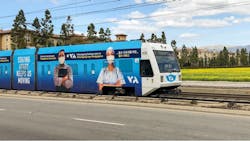Bay Area transit agencies syncing schedules to improve transfers between systems, align schedule changes
Bay Area transit agencies are syncing schedules, with a focus on improving transfers between systems and making schedule changes at the same time.
Most Bay Area transit agencies are rolling out new schedules during the week of Aug. 12 in coordination with each other and are working to align the timing of schedule changes twice each year, once in summer and once in winter. There has been a 250 percent increase in the number of transit agencies changing their schedule concurrently twice each year and six of seven major transit providers are syncing their schedule changes at least once a year.
Bay Area transit agencies convened during a meeting in March 2024 to share planned changes for mid-August and to look for opportunities to improve transfers. Advancing schedule change alignment is a key priority for Bay Area transit general managers who meet on a weekly basis to make transit more rider-focused and efficient. The major agencies are already working on another iteration of a coordinated schedule change to go into effect in January 2025. The coordinated schedule changes will benefit current transit riders while attracting new riders.
Some key examples of improved coordination from the mid-August schedule changes:
- In the North Bay, a series of coordinated changes between Sonoma-Marin Area Rail Transit, Golden Gate Transit and Marin Transit will improve service and connections along the congested Highway 101 corridor.
- The Napa Valley Transportation Authority is making changes to Route 29 from Redwood Park and Ride to the El Cerrito del Norte Bay Area Rapid Transit (BART) station to enhance the bus-to-train transfer timing, which will make 71 percent of the trips have a five- to 10-minute transfer time at El Cerrito del Norte as opposed to 23 percent with the current schedule. The change will positively impact as many as 16,465 riders annually.
- The Alameda-Contra Costa Transit District and Golden Gate Transit have improved schedules to be more coordinated at El Cerrito del Norte Station and along Cutting Boulevard west of the BART station. The alignment will enhance reliability for riders traveling between Marin and West Contra Costa counties via the Richmond-San Rafael Bridge
- In San Francisco, Calif., Muni is making changes to improve regional connections, specifically, the 28 19th Ave. bus schedule serving Daly City BART station is changing to ensure East Bay riders can catch the last BART train to Oakland, Calif., late at night.
- Santa Clara Valley Transportation Authority is making changes to match upcoming BART and Caltrain schedule changes to ensure timed transfers are maintained at various locations across the South Bay and Peninsula.
- San Mateo County Transit District is improving several bus routes that serve BART stations. One noteworthy change is to bus route 292, serving both Millbrae and SFO BART stations, with frequency to be every 20 minutes from 6 a.m. to 6 p.m. to match BART’s frequency.
- Both BART and Caltrain will make changes to improve some of the rail transfers at Millbrae Station that will go into effect when Caltrain launches its electric service on Sept. 21. With BART’s schedule change on Aug. 12 and Caltrain’s schedule change on Sept. 21, approximately 85 percent of all weekday trains will have a transfer between five and 19 minutes at Millbrae Station. On the weekend, approximatively 90 percent of trains will have a transfer between five and 19 minutes, allowing for both systems to be off schedule a bit but still provide a reliable connection. If trains were scheduled with less than a five-minute wait, delays would frequently break the transfer and result in a longer wait.
Balancing service complexities
While all transit agencies are working to improve transfer timing for Bay Area transit riders, several challenges continue to exist making transfer timing difficult:
- A better transfer for one end of a route may create a worse transfer for other areas of the route.
- Adding service to allow frequencies to match each system requires new funding at a time transit agencies are facing significant budget challenges.
- Transfers between BART and Caltrain at Millbrae Station don’t always line up perfectly because Caltrain has four trains per peak hour and two trains per off-peak hour/weekends. BART has three trains per hour at all times. Both systems are also limited in flexibility due to key system timing points elsewhere.
Other coordinated improvements to come
In addition to schedule coordination, Bay Area transit agencies are working together, along with the Metropolitan Transportation Commission, on significant regional projects that will transform the rider experience, such as unified transit maps and directional signs and fare integration and affordability programs such as the implementation of free and discounted transfers.
